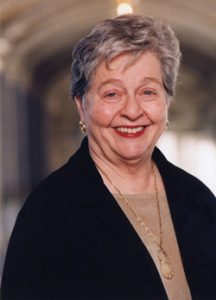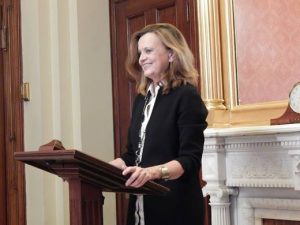By Daniel Dunaief
When Dr. Shirley Strum Kenny was getting ready to leave Queens College to become president of Stony Brook University in 1994, she called her mother in Tyler, Texas, where she grew up.
She told her mother she was taking “a much more important job” and she “burst into tears.”

She felt Queens College had a heart and cared about its students and that she was taking over at Stony Brook where “science ruled” and where the “faculty were more important than students.”
She believed the public university had the “most incredible science faculty for a state institution, but it didn’t have a heart.”
Supported by her husband Dr. Robert “Bob” Kenny, the first female president at Stony Brook made numerous changes during a tenure that lasted until the summer of 2009, overseeing the beautification of the campus, directing the school’s athletic program into Division 1, and forging lasting connections with luminaries including world-renowned paleanthropologist Richard Leakey and celebrated actor Alan Alda.
In a wide-ranging celebrity podcast phone interview from their home in McLean, Virginia, Shirley and Bob Kenny shared numerous stories, insights, observations and reflections, offering specific steps the former president took to bring about cultural change at the university.
“When I got there, students didn’t matter,” said Kenny. “Faculty mattered and we had incredible faculty, particularly in the sciences.”
Kenny appreciated how hard her predecessors worked to recruit and retain talented faculty.
“Each of us played a very different role,” she said.
John Toll, the first longtime president who held the role from 1965 to 1978 “couldn’t have cared diddly squat what the campus looked like or felt like,” said Kenny. “He just wanted the best scientists in the world.”
Kenny believes John Marburger, who was president from 1980 to 1994, consolidated what Toll had done. “I came in at a very different point in history,” said Kenny. “I thought students did matter.”
Changing the campus and the focus of the university wasn’t easy. She said she received numerous figurative bruises along the way.
University leaders thought it was a “waste of time” and money to focus on undergraduates, she said. “We want to be the best graduate university that we can be,” she recalled, echoing the underlying philosophy of the school in the mid- 1990’s. “There was tremendous resistance.”
‘The ugliest campus in America’
Kenny brought in famed architect John Belle, who had worked with her at Queens College and had also been involved in the 1990 restoration of Ellis Island.
“The first important thing I did was to change [Stony Brook] from the ugliest campus in America to the beautiful campus it is now,” said Kenny.
When Kenny arrived, the area that is now the central mall was asphalt. She and Belle, who was one of the founders of architecture firm Beyer Blinder Belle, walked the campus.
Belle asked Kenny if the university had a center and “it really didn’t,” she said. Buildings went up here and there, seemingly without much consideration for developing aesthetically pleasing and relaxing outdoor green space.
Kenny also urged Belle to add a fountain, building on her experience at the University of Texas at Austin, where the fountain became not only a focal point for gatherings and activities but also a place to celebrate.
While Stony Brook doesn’t condone throwing people in the fountain, the way students did in Texas, the fountain has become a “central campus focus” and a place to show prospective students touring the university, she said.
Kenny also helped build and expand the student center, which created a place for students to interact and “have fun,” she said.
Important partners
Through easy-going laughter and self-deprecating humor, Shirley described meaningful and important partnerships that helped shape the direction of the school, academic opportunities and campus life.
Kenny described inviting Charles Wang to lunch. At the time, she was president of Queens College and he was the chief executive officer of Computer Associates.
“I thought I was being so sophisticated,” she laughed. “Here I am, Shirley, from Tyler, Texas. I thought, ‘He knows Chinese food. I’ll take him to a Korean restaurant.’”
Wang, as it turns out, was a Chinese food gourmet and thought she was mixing up his Chinese background with that of Korea.
“He never let me forget what a terrible mistake I’d make,” Kenny said. “He thought I didn’t know the difference between Chinese and Korean.”
She considered Wang one of her several brothers in her academic career.
Kenny met Richard Leakey at a lunch in Manhattan. She intended to see if Leakey might give a lecture at Stony Brook, but started by asking him why he was in New York.
He had come for new prosthetics, after he’d lost his legs in a suspicious plane crash in 1993 when he was working to save endangered elephants and eliminate the trade in ivory tusks.
When she found out he didn’t have insurance, she encouraged him to become a visiting faculty at Stony Brook, where he could get insurance.
“That connection with Leakey and the Leakey Center has endured since then and has been very important to the university,” said Kenny.
Shirley met actor Alan Alda of MASH fame at a dinner at the Staller Center.
Alda shared an idea he pitched to other university presidents around the country that deploys improvisational acting techniques to communicate and, in particular, to share information about science.
Kenny was receptive to the idea, which led to the Alan Alda Center for Communicating Science.
A life partner
Shirley and Bob Kenny shared anecdotes and advice about their lifelong partnership.
The couple, both of whom grew up in Texas and met as undergraduates at the University of Texas when they worked for the school newspaper, have been married for 68 years.
When asked for the key to such a lasting marriage, Bob suggested it was “patience and tolerance.”
Shirley suggested the scales weren’t balanced as her husband “had to be patient with me more than I have to be patient with him. I’ve never doubted how clever I was to hook him.”
The Kennys have four grandchildren and a great grandchild.
The couple, who don’t travel as often to the university as they had in the years after leaving Stony Brook, maintain a close connection to the school through their daughter Sarah Azzara, who is a Full-Time Lecturer in the Program in Writing and Rhetoric at Stony Brook.
The next leader
While the Kennys aren’t involved in the current search for a new president at Stony Brook, Shirley shared some thoughts on the qualities she’d like from the next leader.
“What I really want is somebody who cares about Stony Brook and who is not just looking at this as a weigh station to a more ‘prestigious’ presidency,” she said. “The last few people have been on their way to other presidencies.”
She would like someone who “loves and cares about Stony Brook and wants to keep making it better.”
As for advice she’d share with anyone contemplating becoming a university president, Kenny suggested the importance of hearing other people.
“You need to be able to listen and not just talk,” she said. Presidents need to be sensitive to “what the campus wants, as well as having your own vision of where you think it should be going.”
Even if a prospective leader believes in a particular vision, that person “shouldn’t just pronounce and do, even if [he or she] thinks they have a wonderful vision.”
She urged universities and their leaders to focus on recruiting extraordinary teachers as well as talented researchers.
Robert Kenny spent 12 years without electricity, then rose to top academic posts
When the lights go out, Robert Kenny feels like he’s home.
“I react by saying, ‘Yeah, I’ve been there. I’ve been to this place,’” said Kenny.
That’s because, for the first dozen years of his life, Kenny had no indoor plumbing or electricity on what he described as a “hard scrabble farm” in Texas.

“I grew up basically in the 19th century,” said Kenny, from the current home he and his wife of 68 years Shirley share in McLean, Virginia.
Kenny brought buckets of water from the windmill to the house, while his mother cooked on a four-burner wooden stove.
The family, which farmed land to raise cattle for beef, had a battery powered radio powered by a windmill on the roof of the house.
When the wind blew, the battery charged and the family could listen to news and entertainment, but when the air was still for longer periods of time, the radio wouldn’t function.
Kenny also lived in a home with a phone that looked like a box with a crank. His neighbors, whose homes were about a mile away, all had similar boxes connected to one line.
Everyone was on the same line and a call to each family had a distinctive ring.
When the summer evenings got too hot indoors, the family took their beds outside and slept under the sky.
“It was terrific,” recalled Kenny. “I enjoyed it. You tended to wake up early.”
On the unusual night when it rained, the family would bundle everything up quickly and race indoors.
“I knew from childhood that I wanted to leave that world,” said Kenny.
When the family finally received electricity, Kenny was thrilled that he could read in the evening as long as he was allowed to stay up.
Kenny’s parents were “very supportive of education,” he said. “That’s what made” it possible for him to leave the farming world and enter academia.
Army counterspy
Before adding to his academic resume, Kenny served as a counterspy in the army.
“That was the age in which everybody was suspected of being a communist,” said Kenny. “The army was very worried about people becoming subverted and becoming spies.”
His unit’s job was to search for people who might be susceptible to any leverage the Russians might find.
“At that time and one hates to say it now, the Army was very suspicious of homosexual activity,” he said. “They thought [gay soldiers] were vulnerable to blackmail.”
When his unit found gay men, they were “usually pushed out of the Army,” he said.
That, Kenny said, proved ironic, because he was sure at least one of the people in this counterspy group was, himself, a closeted gay man who rose through the ranks.
While he was in the army, Kenny married Shirley Strum, who decades later would serve as the first female president of Stony Brook University.
Kenny, meanwhile, built on his love of reading and appreciation for education, becoming Dean of the Columbian College of Arts and Sciences at George Washington University.
Real world lessons
While dedicated academics, the Kenny couple received difficult lessons in the real world during their honeymoon.
They were robbed twice on their honeymoon, first in Miami and then in Puerto Rico when they swam in the hotel swimming pool.
When they returned to the United States, Bob Kenny had to call his commanding officer to ask for an advance on his money so he could get back to the base.
Looking back on his over 90 years of life, Kenny suggested he especially enjoyed his 20s, when he could travel the world. He also reveled in the 40’s, when the family enjoyed time with their young children.
He described visiting the shrine at Delphi in Greece as being “absolutely eerie and magical.”
As for the way he best supported his wife during her tenure as the president of Stony Brook, Kenny suggested that his role was as a “listening post” and a “place to vent where she could express her frustrations.”
Looking at an academic legacy that has continued through the generations, with their daughter Sarah Azzara at Stony Brook and grandchildren including Avi Kenny, an Assistant Professor of Biostatistics & Bioinformatics at Duke, the Kennys are proud of their ongoing academic legacy.
For Bob Kenny, such academic success came from a humble beginning.“Books were not easy to come by in that part of the world,” he said. “I read everything” he could get his hands on. His favorite was Mark Twain’s “Tom Sawyer.”



















